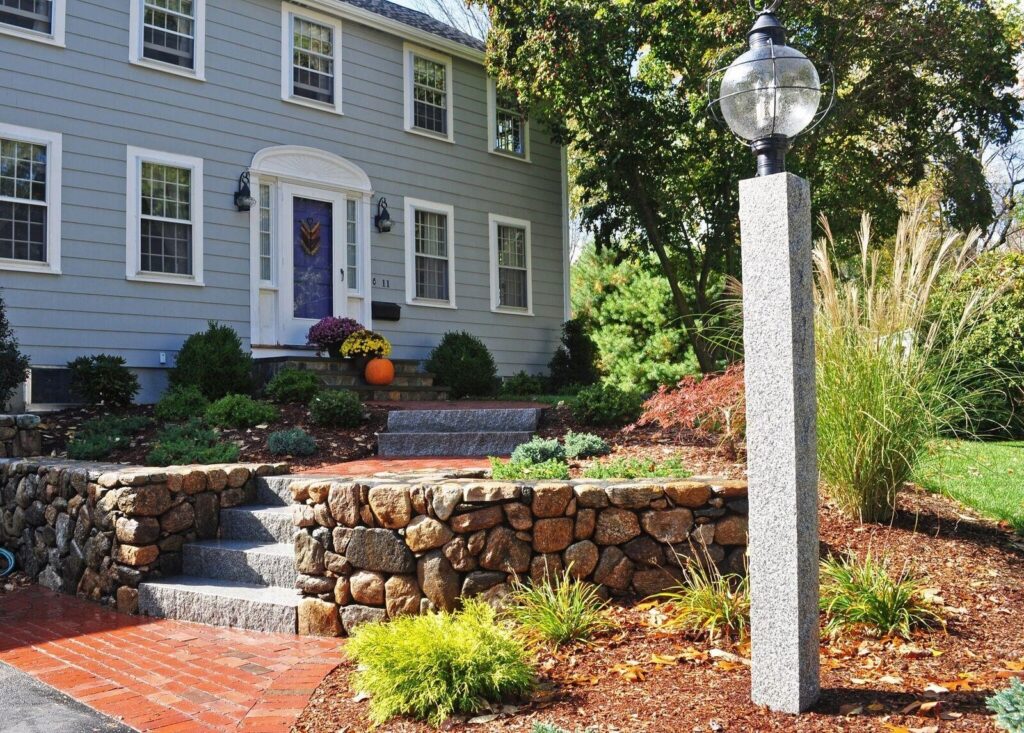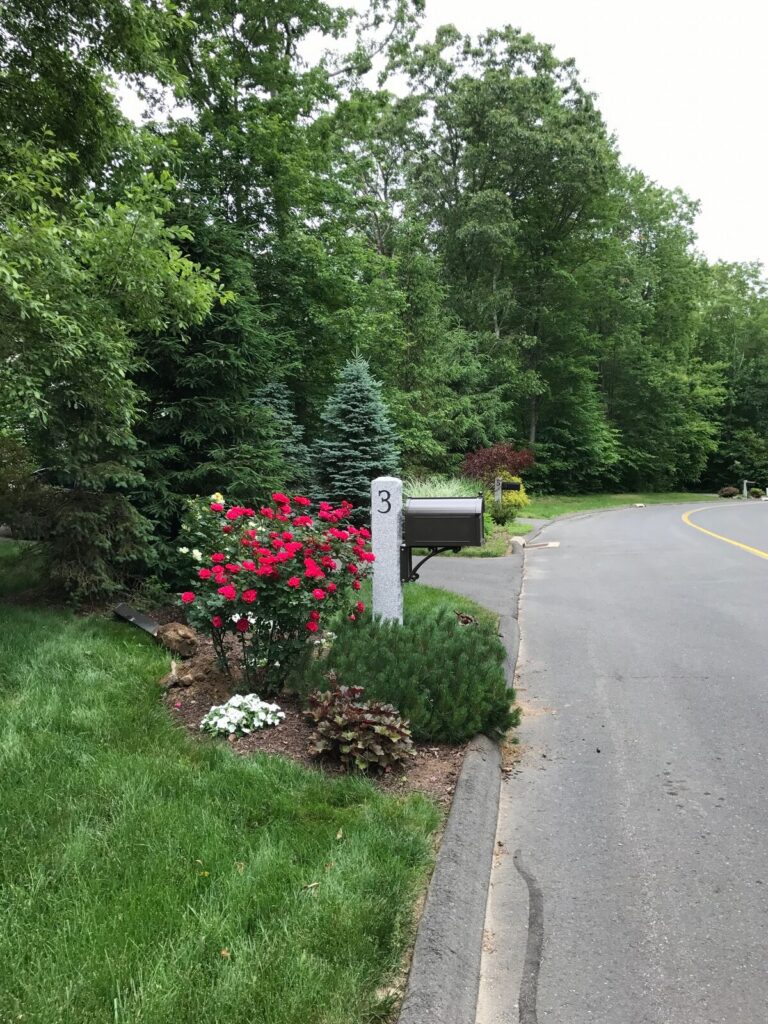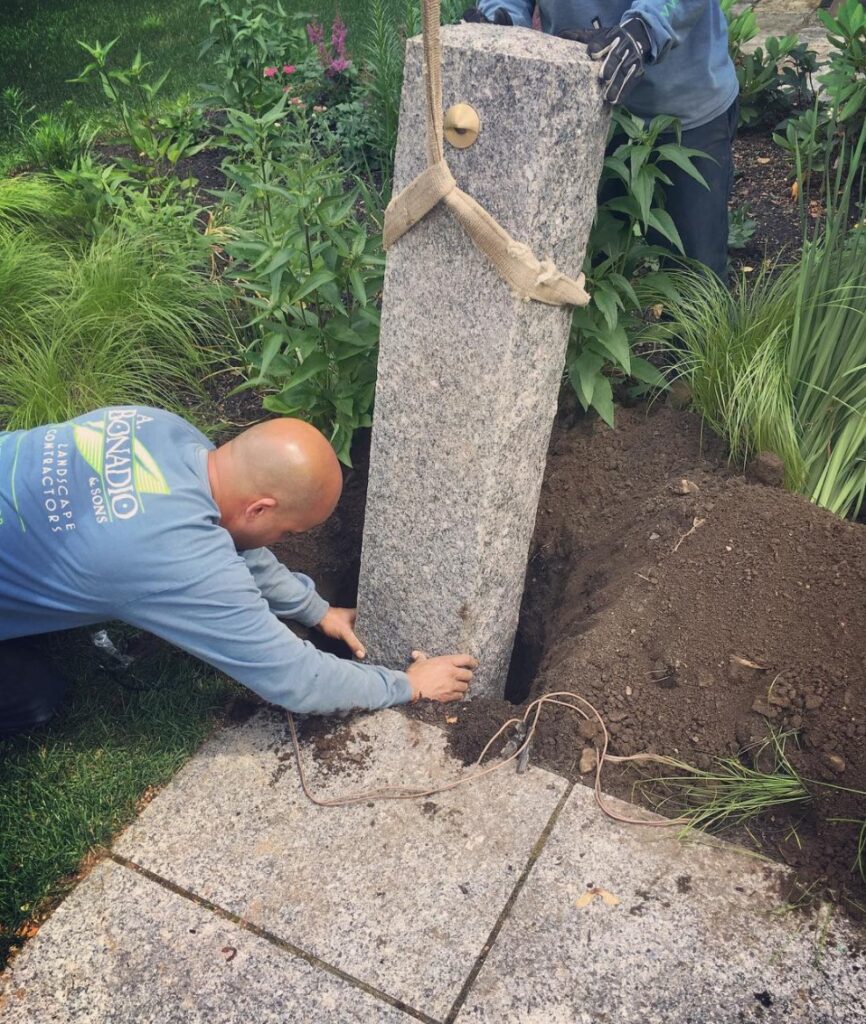The Dirt on Digging Holes for Granite Fence Posts, Lamp Posts and Mailbox Posts

If you are ready to light your landscape, create a rustic fence line, or upgrade your mailbox with granite, it’s important to know how you’re going to dig those post holes.
A post hole is more than just a hole in the ground. It is a narrow, straight, and deep cut into the earth at a particular size, in a particular place that could possibly contain obstacles such as large stones, roots, ledge or utility lines.
When digging holes for granite posts, there are certain things you should keep in mind before you start your project. This information will help you get the job done yourself, or it may influence your decision to hire a contractor.

A Woodbury Gray granite lamp post installed by Seoane Landscape Design.
preparing for the dig
Before starting the project, call Dig Safe® to mark out any utilities. Once the lines are marked, the hole can be dug using various methods.
Dig Safe® is a not-for-profit clearinghouse that notifies participating utility companies of your plans to dig. These utilities respond to mark out the location of their underground facilities.
State law requires you to notify Dig Safe for even small projects, like installing a mailbox post or planting shrubs. The depth of utility lines varies, and there may be multiple utility lines in a common area.
In Massachusetts, Maine, New Hampshire and Rhode Island, state law requires a minimum notification of 72 hours, and 48 hours in Vermont prior to the start of the project (weekends and legal holidays not included).
THE DIGGING PROCESS
Have the proper tools and equipment on hand. Post hole diggers, shovels, augers and mini-excavators can be used, though most small post jobs will require a basic pointed shovel.
Cut out a square or round area of appropriate size out of the sod or loam with a sharp spade or lawn edger and use a shovel or post hole digger to excavate the hole until it is deep enough to set the post at the correct height.
The hole should be deep enough to submerge the approximate bottom third of the post below ground. The ideal diameter should measure three times the width of the post. Please contact a Swenson representative about your specific post for clarification on measurements.
Pile the excavated gravel near the hole for compaction after the post is set into the ground. Depending on the amount and size of rocks you pull from the hole, you may need to obtain additional clean gravel to refill the hole.
If you are installing a mailbox post, check with your local post office to confirm their requirements for the height of the box, as well as distance from the street that the post needs to be installed. Each individual postal office may have varying regulations.
Typical U.S. Postal regulations require the height from the street level to the bottom of the finished installed mailbox to be approximately 40” to 44”. A stock-size 7” x 7” x 7’-0” granite post would need a hole 30” deep, and 18” in diameter.
Remember to take into consideration the height of any street curbing as well. Add the curb height to the overall depth of hole if there is existing curbing at the street. For example, if the height of the curb is 6”, the hole needs to be 36” deep as opposed to 30” in order to keep the mailbox at the proper height.
Varying USPS height requirements, as well as any engraving or non-stock accessories added to the post may also require a longer, non-stock post so that proper mailbox height can be maintained.

An engraved Woodbury Gray granite mailbox post.
SETTING THE POST
You can set the post in either gravel or concrete. At Swenson we recommend you set the post in gravel, which is easily permeable, drains well and provides strong reinforcement. When setting the post, you should bury approximately one-third of it underground.
If you have very loose, sandy soil, you might want to consider setting the post in concrete. We have some contractors who prefer setting posts in concrete to prevent shifting. There is, however, a risk of the post snapping when set in concrete if struck by a vehicle, utility equipment, etc., especially during the winter months. Gravel will allow the post to shift and provide an opportunity to adjust it afterward should any accidental impacts occur.
When you begin refilling the hole around the post, be sure to compact in layers after every four inches of gravel is shoveled into the hole. Trying to compact too deep of a layer at one time will not allow for proper compaction, and you might end up with voids along the way, causing settling and leaning over time.
Space will likely be very tight around the post toward the bottom of the hole, requiring you to use the narrow handle end of the shovel to compact the gravel at the start. A long-handled sledge hammer can help to compact as you move along, since the hammer head is small and heavy. Above all, use a 48” long level to be sure your post remains true throughout the compaction process. It is nearly impossible to adjust for level once proper compaction is complete.
The top four-inch layer of compaction should be the loam you excavated at the start, allowing you to seed, replace sod and plant flowers.

A.Bonadio & Sons, Inc. Landscape Contractors installing a Woodbury Gray granite post.
UNEXPECTED OBSTACLES
When digging a hole, it’s important to be prepared for the unexpected. There is always the possibility that you could run into large stones, boulders, or ledge, and utility, gas or irrigation lines. Sometimes the hole might need to be relocated because of these obstacles.
WHEN TO DIG
In New England, the ideal time to dig is after the ground thaws in the spring or before it freezes in the winter.
Now that you’ve got the dirt on digging post holes, you can get started with a better understanding of the process. If you do opt for help, contact a Swenson Granite Works location near you and we can connect you with a contractor in your area.
